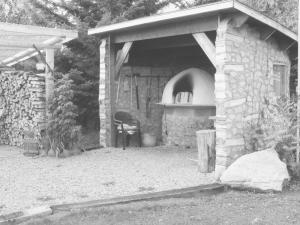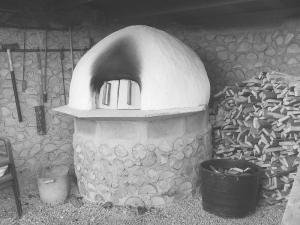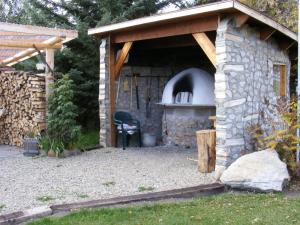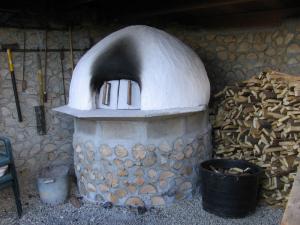2008 - Volume #32, Issue #3, Page #40
[ Sample Stories From This Issue | List of All Stories In This Issue | Print this story
| Read this issue]
"Cordwood Kitchen" Feeds Family Outdoors
 |
 |
 |
 |
"I used White Poplar firewood that I cut into 9-in. long pieces, building the walls up by a couple of feet each day, giving them time to dry in-between. The wood must be really dry when you cement it in û mine was dried for a couple of years," Hans explains. "I have cement footings to keep the base of the oven and shack level, plus they protect the wood from ground moisture. We've got two windows in the shack for light, and they let us see out to the driveway."
The 12-ft. wide shelter has a sloped, tar-shingled roof that's 10 ft. tall in the front, and tapers to 7 ft. in back. Pfaeffli cemented the roof trusses into the wall for durability.
Pfaeffli filled the center of the oven's cordwood base with rocks, concrete chunks and sand to increase its heat-storing capacity. He then capped it with a 3 in. thick concrete slab he made with refractory cement. This forms the baking surface, and juts out about a foot from the 4-ft. dia. base, providing "counter space."
Over the course of six days, Pfaeffli used two forms to make 12 orange section-shaped pieces of refractory concrete. Together, they form the dome shell, which sits on top of the base, creating the oven cavity (with an opening for access). He also made two small blocks with handles, using the special cement, and these serve as oven doors.
Pfaeffli covered the dome with rock wool insulation (similar to fiberglass insulation mats), chicken wire, and stucco. He says it insulates very wellà after a big fire, you can put your hand on top of the dome, and it's barely warm, according to Pfaeffli.
"The refractory cement was necessary so it doesn't crack or crumble from the high temperatures," he says. "It was my biggest cost - about $1,000."
For baking bread, Pfaeffli first removes the doors and makes a large wood fire inside the oven, burning it for an hour or two. Then, he scrapes it all out, puts in his bread dough, and closes the doors. He bakes a dozen loaves at a time, and they're ready in an hour.
Pfaeffli uses the oven year-round to bake bread and, thanks in part to large trees nearby, there's enough shelter that no winterizing of the cook shack is necessary.
"For cooking things like pizza, roasts, potatoes, and vegetables, I make a fire, preheat the oven for at least an hour, then push the charcoal off to one side, and put the food in to cook while the fire's still burning. I keep the heat constant by adding a little wood as necessary. I put everything I need for a meal in there at the same time and just move it around, according to the temperature each dish requires," he explains.
Contact: FARM SHOW Followup, Hans and Marianne Pfaeffli, P. O. Box 5485, Westlock, Alberta, Canada T7P 2P5 (ph 780 349-5576; fax 780 349-5629).

Click here to download page story appeared in.

Click here to read entire issue
To read the rest of this story, download this issue below or click here to register with your account number.




